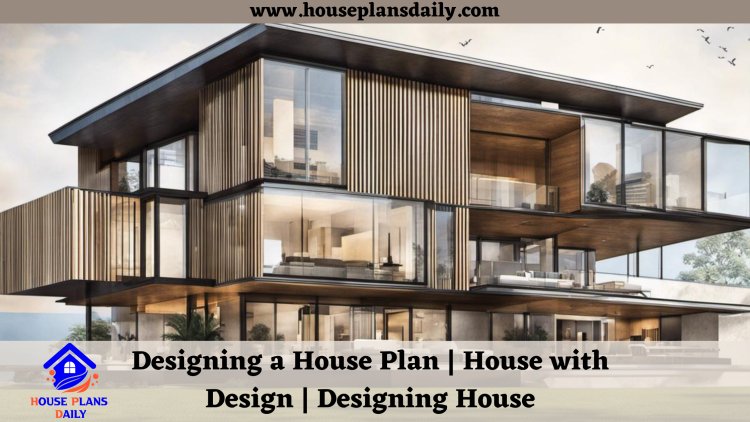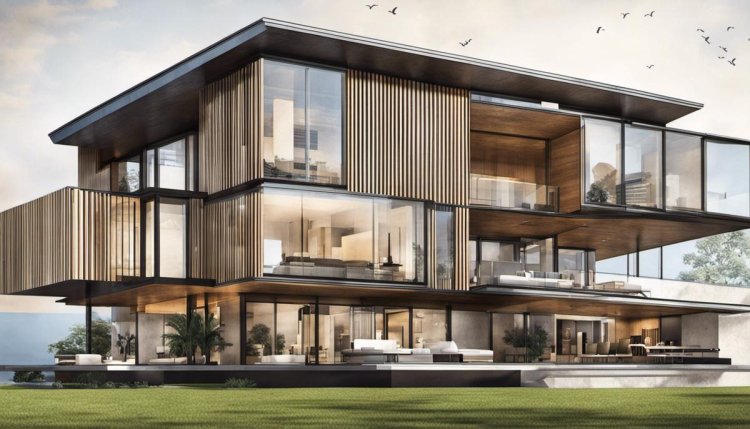Designing a House Plan | House with Design | Designing House
Designing a house plan is a meticulous and rewarding task that requires an understanding of multiple architectural, design, and legal aspects.
Designing a house plan is a meticulous and rewarding task that requires an understanding of multiple architectural, design, and legal aspects. It’s about visualizing a space that should not only look aesthetically pleasing but strike an ideal balance between functionality, comfort, legal compliance, and cost-effectiveness. In this context, you will learn about different types of architectural drawings and how to interpret them, the principles of successful space planning, understanding relevant building codes and regulations, and the implications of different materials and construction methods on the overall design of your house plan.
Architectural Drawings
Understanding Architectural Drawings Types
Architectural drawings are visual tools used in the planning and execution of construction projects. There are several types of architectural drawings, but the most common ones include plans, sections, and elevations. Each of these drawing types has a distinctive role in conveying the right information about the building design.
Grasping House Plans
House plans are a type of architectural drawing that provide a bird’s eye view of a building. They are used to illustrate the configuration of rooms, the position of interior features, and the location and dimensions of walls, doors, and windows. To design a successful house plan, you must understand how to read and interpret these drawings. Start by identifying the key elements such as walls, doors, and windows, which are generally marked with standard architectural symbols. Pay attention to the scale, represented ratios used to determine the actual size of each element in real life.
Deciphering Sections Drawing
Section drawings are architectural drawings that depict a vertical cut of a building. This includes showing interior elements such as floor levels, stairs, windows, and often furniture. This view allows you to comprehend the interior spatial relationships and heights within the building, helping design an accessible and comfortable living space. To read a section drawing, identify the cut line marked in the plan view and explore how the sections are taken from that line.
Understanding Elevations
Elevations are a type of architectural drawing that displays one side of a building. In house design, there are typically four elevation drawings used for each side of a house: front, back, left, and right. Elevations provide an exterior view of the building and indicate the materials to be used, the style of windows and doors, and other design elements. To understand an elevation drawing, you start by noting the key descriptive labels and features. Identify the ground level and notice the exterior elements such as doors, windows, and their proportional relationships.
Importance of Architectural Drawings in House Design
Comprehension and interpretation of architectural drawings play a pivotal role in the successful execution of a house design. They provide a comprehensive picture of what a finished project should look like from multiple perspectives. Understanding these drawings enables efficient communication with the architects and builders, ensuring the end product matches your vision.
Interpreting Architectural Drawings
To interpret these drawings accurately, it's imperative to familiarize yourself with architectural scales, symbols, and annotations. Use the title block, usually found at the bottom or side of the drawing sheet, to understand key details about the project. Don't hesitate to ask your architect for clarification when needed. Lastly, always view all drawing types in conjunction, as they provide different aspects of the same design.

Space Planning
Understanding Space Planning
The primary step when designing a house plan is understanding the concept of space planning. This involves determining how a room or a space will function, the flow of movement, the balance, and the visual impact of each element from floor to ceiling. To design a house plan precisely, that meets your needs, you should be able to envision how to allocate space for different rooms according to their functions, size, and relationship to each other.
Considering Ergonomics in Designing
Ergonomics plays a vital role in house planning. It is the process of designing or arranging spaces, systems, and products so that they fit the people using them. When creating a house plan, you should consider the anthropometry – the height, reach, and other physical attributes of the users. The home layout should provide comfort and ease the movement, for example, consider the height and the location of windows, wardrobes, and kitchen counters, etc.
Circulation and Flow Pathways
Another crucial factor in space planning is the circulation, or the paths people will take through the space. This includes designing the layout of rooms, doors, furniture, and other elements in such a way that they facilitate easy mobility within the house. For example, a clear pathway should be there from the entrance to the living areas, and from the living room to the kitchen and so on. There should be ample space around the furniture for people to move freely.
Impact of Planning on Comfort and Functionality
The way you plan and allocate space for different rooms can significantly impact the comfort and functionality of a space. A well-planned living area will ensure enough room for movement and activities, while a poorly planned living room might feel cramped and uninviting. Similarly, a kitchen needs enough counter space for preparing meals, and bedrooms need to be quiet and private.
Balancing Between Room Sizes
Creating a balance between different room sizes is essential when designing a house plan. Consider the function of each room and assign space accordingly. For instance, a living room or family room may need a larger area as they are spaces for family gatherings and socializing. Bedrooms may require less space but they need to be planned for comfort and privacy.
Understanding the Relationship Between Rooms
Identifying the relationship between rooms is vital for a functional layout. Room relationships can affect the lifestyle and convenience factor of the residents. For instance, the kitchen should be located near the dining area for ease of serving. A bathroom should ideally be close to or attached to a bedroom for convenience.
By carefully planning your spaces considering ergonomics, circulation paths, and room relationships, you can enhance the comfort and functionality of your home, making it more livable and enjoyable.

Building Codes and Regulations
Understanding Local Building Codes and Regulations
Building codes and regulations vary greatly from one region to another, and they contain specific requirements for designing and constructing a residential building or house. These rules typically govern various aspects of the design, including the building's height, its distance from the property line, fire safety measures, and even specifics relating to the building's construction materials or methods.
Researching Local Building Codes
To design a house plan that complies with all local requirements, start by researching the building codes and regulations of your area. This information can typically be obtained through local government agencies such as the planning department, zoning department, or the office of building safety. Many jurisdictions also publish this information online for the convenience of builders and homeowners.
Key Areas of Building Codes
While reviewing the local building codes, pay special attention to the following areas:
- Building Height Restrictions: Most residential areas have limitations on the height of buildings. Make sure to know the maximum allowed height in your area before designing a house plan.
- Setback Requirements: These regulations control how far your house must be situated from the property line. These distances, or setbacks, are crucial to determining your home's placement on the lot.
- Fire Safety Requirements: Building codes also outline specific requirements for smoke alarms, fire-resistant materials, and egress windows to ensure residents can safely escape in the event of a fire.
- Material and Methods Requirements: Building codes may also specify certain material and building method requirements to ensure structural integrity and safety.
Compliance with Building Codes and Regulations
Once you understand the local building codes and regulations, incorporate these rules into the design of your house plan. During this process, it may be necessary to adjust your design goals to align with local compliance requirements.
Professional Consultation
Finally, consider consulting with a professional architect or a building inspector. They will have the expertise and experience to guide you through this process, and can provide additional insights into meeting building codes and regulations.
Remember, any construction or renovation work that doesn't comply with local building codes and regulations can lead to fines, delays, and could even mean having to redo some or all of the project. Therefore, understanding and complying with these rules before your house plan is finalized is critical.

Materials and Construction Methods
Understanding Available Materials for House Construction
Gaining knowledge on construction materials available for your house is the starting point of your house plan design. This involves looking into various material options such as wood, steel, concrete, or composite, each offering unique advantages and disadvantages.
Wood
Wood is a traditional choice, offering a warm and classic aesthetic. It's easily available and relatively simple to work with. However, wood requires regular maintenance to protect it against termites and water damage.
Steel
Steel is sturdier and more durable than wood, making it a good choice for areas prone to extreme weather conditions. It's also resistant to fire, mold, and termites. However, steel's higher cost, the technical knowledge required for its installation, and its susceptibility to rust can be deterrents.
Concrete
Concrete is known for its strength, durability, and fire resistance. It's also a popular choice for energy-efficient homes due to its insulating properties. However, concrete is costly, requires skilled labor to install, and doesn't provide a warm aesthetic appeal.
Composite Materials
Composite materials, such as fibre-reinforced polymer composites, are gaining popularity. They offer strength, durability, and resistance to weather conditions and pests, but they can be expensive.
Exploring Construction Methods
Various construction methods are available, each with their benefits and drawbacks.
Traditional Brick and Mortar Construction
Traditional brick and mortar construction provides a strong and sturdy structure but requires a considerable amount of time due to the manual labor involved.
Prefabricated Construction
Prefabricated construction involves manufacturing sections of the house in a factory, then assembling them on-site. This method can be quicker, more efficient, and reduces waste, but the design options may be limited.
Steel Frame Construction
In steel frame construction, steel columns and beams provide the structure's skeleton. It's a sturdy and durable option but requires specialist skills and equipment.
3D Printing Construction
Lastly, 3D printing construction uses a printer to create building components or entire buildings. It's efficient and reduces waste, but is still a relatively new method with limited availability and higher costs.
Sustainability, Budget, and Timeframe Implications
The choice of materials and construction method can significantly impact the sustainability, budget, and timeframe of your house project.
Sustainable materials and construction methods minimize environmental impact and can save energy costs in the long run. However, they can be more expensive upfront.
The choice of materials can greatly affect the budget. While wood is relatively cheap, steel and concrete tend to be more expensive. The construction method also affects the cost, as some methods like prefabrication can help reduce labor costs.
Timeframe is another crucial factor. Traditional methods take longer, while prefabrication and 3D printing can significantly speed up the process. However, faster methods may compromise the customization possibilities.
Therefore, learn as much as you can about the various building materials and construction methods. Consult with professionals to help understand which option would be the best fit for your unique design, budget, and timeframe requirements.

By understanding the importance of architectural drawings and the science of space planning, you've learned how to interpret different spatial designs effectively. The knowledge you have gained about allocating space according to the function of rooms and their relationship with each other will significantly enhance the comfort and functionality of your future home. Familiarity with the relevant building codes and regulations and how to ensure compliance alongside an insight into various materials and construction methods will further equip you to make informed decisions concerning design, sustainability, budget, and construction schedule. As you continue your journey in designing your house plan, take these learnings with you as powerful tools to create a sustainable, functional, and beautiful home.















